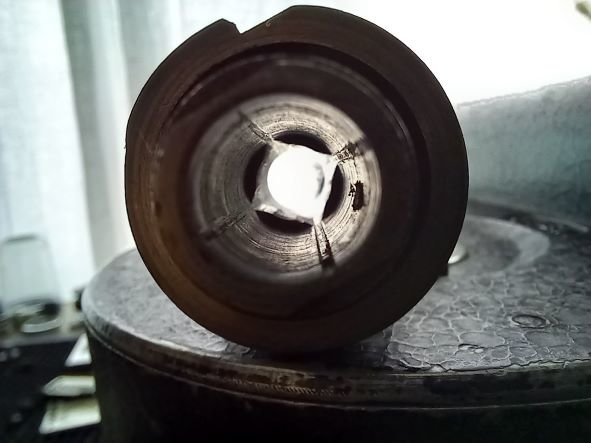-
Posts
2,588 -
Joined
-
Last visited
Everything posted by Simon Wyss
-
Yes, Saul, I think we're close to the thing. I'd have imagined the operator set the speed wrongly after some work. Might have come anywhere in the roll. Good luck, Daniel!
-
Well, with that combination of shutter angle, frame rate and light pulse there should be no fluctuations, constant speed provided. It would have to be the motor running wild. Now as you say daylight the camera issue falls away. Left only light pulsation with the scanner. Good scanners employ DC fed light sources such as LEDs on accumulators to exclude all interferences. Check on that point, insist that they explain. Sometimes also the scanner's speed is set incorrectly which will provoke that dark-light-dark-light.
-
It appears to be interference between frame rate and lighting frequency. With a 172.8 degrees shutter opening 24 times a second you get exactly two intersections with 50 cycle mains. That would explain but you had 60 Hertz mains for the shoot, hadn't you?
-
You shot at 24 fps I presume. At what pace are the fluctuations, I mean timewise?
-
Memochrome*. 32,000 frames freely programmable, Excel management, 50 steps per color (RGB), instant repeat. I am not yet happy with the Schwarzschild corrections but that will come. It's a light control over time in conjunction with step printers. At value 1 the exposure is shortest, at 50 longest. Terrific precision
-
Rubbish! Your H camera eats triple thickness. You may load thinner film on the other hand.
-
That's what this MKBK looks like.
-

gaffers tape color coding
Simon Wyss replied to Jason Hinkle RIP's topic in Camera Assistant / DIT & Gear
I beg your pardon. Everything is fine. Have been a bit too sensitive. Like pressure sensitive tape. Never mind :mellow: -

Operating in 4:3
Simon Wyss replied to Gavin Keen's topic in Students, New Filmmakers, Film Schools and Programs
Don't we all enjoy Gilmore Girls in 3:4? -

Operating in 4:3
Simon Wyss replied to Gavin Keen's topic in Students, New Filmmakers, Film Schools and Programs
Gavin, congratulations! Lucky man, worship the standard image aspect ratio of three to four, cognize its dymanics, the waltz rhythm, how you can slip into diagonals. Here is one who praises 3:4 and tells you. Full stop. -

gaffers tape color coding
Simon Wyss replied to Jason Hinkle RIP's topic in Camera Assistant / DIT & Gear
Then it seems to me that I am used to keep order in the dark while the crew produces a mess in the light. Why in the world can an exposed portion not be brought back to its can? Don't you keep empty and unlabeled cans in a place for short ends? I always wonder at how archaic procedures are with million dollar budget film productions (or less) right on the level of film. -

gaffers tape color coding
Simon Wyss replied to Jason Hinkle RIP's topic in Camera Assistant / DIT & Gear
It's a fine thing for us lab people to receive exposed stock in cans with white tape around with black felt marker identification on saying exposure rate footage. It is a very sad fact that many camera people, from 2nd to DoP, cannot leave the original sticker on the can as it is, they scribble and paint and paste over it so that for instance the batch numbers are illegible. Please, simply write on the tape around the rim if you feel you must write besides the camera report. The tape we shall be looking at because, you know why. -
Why not dive with an Arriflex II C. Only to fix this little issue of engineering interest: Arriflex II has no register pin. The movement is known to have a hole-fitting claw or pin but this is still moving.
-
H 16, Nr. 31228, was sold on November 11th, 1946, for 975 Francs with Switar 25-1.4 AR, Nr. 31031. The Yvar 75-2.8 AR, Nr. 34774, cost 252 Francs that day. Plus 4 % Umsatzsteuer, sales tax, but no luxury tax. By the way, the first H model: Note winding key on spring core Soon it was changed like this: Note point 20 on screw cap where the wind key still could be inserted, and the square dog of the wind crank Greetings
-
Clunky
-
If you want to learn from a title graphics specialist make contact with Carlo Piaget. He lives in Bienne, Switzerland, has made a couple of cartoon movies and produced a short feature with one of his 2709, starring Eugène Chaplin. Carlo is a friend of mine and truly a title artist. carpia@bluewin.ch
-
The 100-foot so-called daylight camera spools have closed blackened flanges and a closed hub. There is always an additional length of film given like 110 foot. You use that length for lacing and as light protection for the inner windings, about 6 foot at the beginning and about 4 foot at the end. Only prevent the outer windings from unrolling by holding the pack together in one hand while you feed the first two foot or a little less with the other hand. Depends on the camera you have. You load and unload the camera in the shadow, when in full sunlight then turn yourself around to cast shadow. Best is to sit somewhere and have the camera on your legs, lens pointing away from you. The workers with the laboratories have the right to cut off the fogged (additional) lengths and you have the right to get back 100 feet, net (4000 frames). They may splice leader to your original. Help them by producing a first and a last frame, i. e. after threading up you run the film forward through the closed camera (lens hood, variable shutter, reflex viewfinder) until the counter reads Zero. At this point you zero the single frame counter, too. Expose 4000 frames and not more. After that you let the film run out (audible) in the again closed camera. Niet vergeten All the best for your work!
-
Dominic, and I don't want to pick on anybody at all but this case is lost. <_< :)
-
Try Gigabitfilm.
-
We're here.
-
If it is possible for the light magician to let the set shine at half value you may read on that, an average of lowest and full power. That value I'd leave throughout the show.
-
Since you are asking in the 35mm section of this forum and speaking of the theaters I advise to start right away with a camera for 35-mm film. It doesn't matter what machine you grab but that you build relationships with lab people here and there. From the beginning you'll be able to hand your strips to projectionists and enjoy all your successes and failures big on screens. I am not being ironic nor sarcastic. On the contrary most seriously: Go cinema !
-
Dominic, I am getting out of the way. You are so right. Yet the initial question is not answered, and it is not an easy one to satisfy, IMO. “Firstly, how do i determine d-min for a given stock.” What does Benjamin actually want?
-
Certainly


